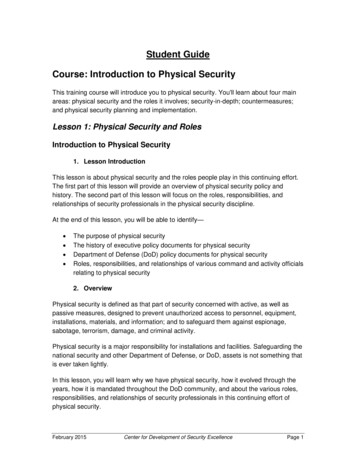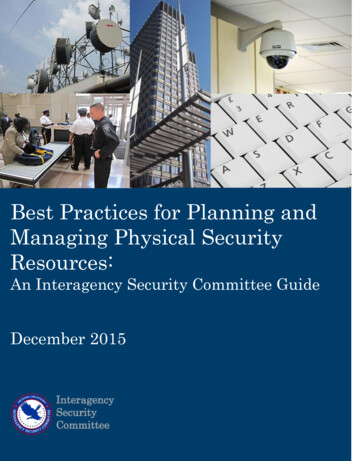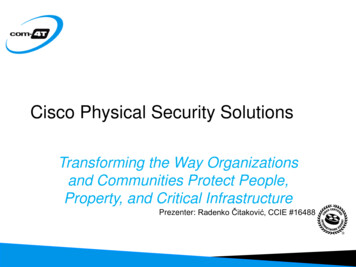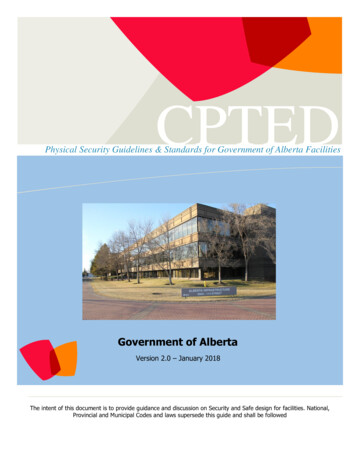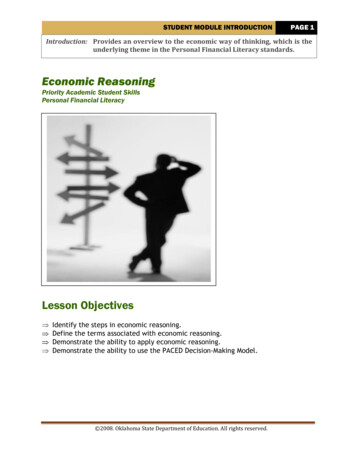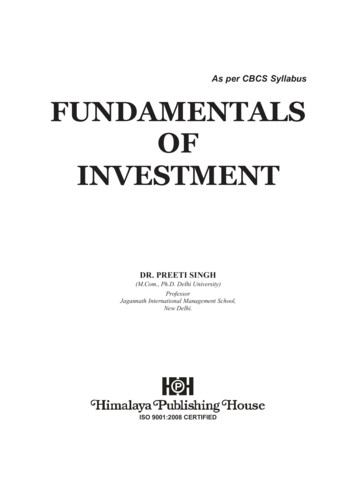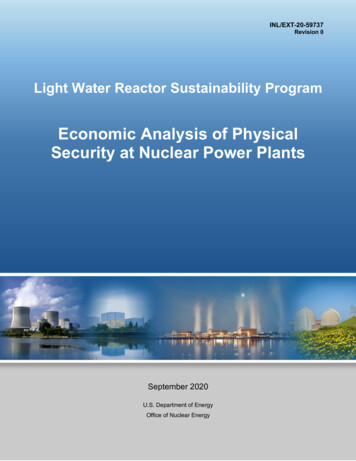
Transcription
INL/EXT-20-59737Revision 0Light Water Reactor Sustainability ProgramEconomic Analysis of PhysicalSecurity at Nuclear Power PlantsSeptember 2020U.S. Department of EnergyOffice of Nuclear Energy
DISCLAIMERThis information was prepared as an account of work sponsored by anagency of the U.S. Government. Neither the U.S. Government nor anyagency thereof, nor any of their employees, makes any warranty, expressedor implied, or assumes any legal liability or responsibility for the accuracy,completeness, or usefulness, of any information, apparatus, product, orprocess disclosed, or represents that its use would not infringe privatelyowned rights. References herein to any specific commercial product,process, or service by trade name, trade mark, manufacturer, or otherwise,does not necessarily constitute or imply its endorsement, recommendation,or favoring by the U.S. Government or any agency thereof. The views andopinions of authors expressed herein do not necessarily state or reflectthose of the U.S. Government or any agency thereof.
INL/EXT-20-59737Revision0Economic Analysis of Physical Security at NuclearPower PlantsPralhad H. BurliVaibhav YadavSeptember 2020Prepared for theU.S. Department of EnergyOffice of Nuclear Energy
ABSTRACTThe overall operation and management (O&M) costs to operate a nuclearpower plant in the U.S. have increased to a point that many utilities may not beable to continue to operate these important assets. The Department of Energyestablished the Light Water Reactor Sustainability Program with the mission tosupport the current fleet of nuclear power plants with research to facilitatelowered O&M costs. The Physical Security Pathway aims to lower the cost ofphysical security through directed research into modeling and simulation,application of advanced sensors or deployment of advanced weapons. Modelingand simulation are used to evaluate the excessive margin inherent in manysecurity postures and to identify ways to maintain overall security effectivenesswhile lowering costs. This effort presents the economic analysis modelsdeveloped with the aim of optimizing the physical security program at nuclearpower plants.This report describes the development of a framework that integrates resultsfrom Force on Force analysis with economic assessment to achieve two closelylinked objectives: (1) Estimation of effectiveness of components of the physicalsecurity posture, and (2) Evaluation of investments in physical security using anestimated cash flow analysis. An econometric model is used for incorporating thesuccess and failure of the physical security posture as determined from Force onForce models. The economic model incorporates various costs associated withphysical security posture at a typical commercial nuclear power plant, such aslabor and personnel costs, non-labor costs, equipment capital costs and operatingcosts. An investment assessment analysis is illustrated using a case study ofperformance and cost effectiveness of remotely operated weapons system in ahypothetical scenario. The framework provides a proof of concept towardsachieving performance and cost effectiveness in design and operation of physicalsecurity posture at nuclear power plants.iii
CONTENTSABSTRACT, SUMMARY, FOREWORD, AND ACKNOWLEDGEMENTS . iiiACRONYMS .v1.INTRODUCTION .11.1 Background .11.2 Current Physical Security Posture.22.ANALYTICAL FRAMEWORK .32.1 Force-on-Force Model .32.2 Econometric Analysis .53.ASSESSMENT OF INVESTMENT .64.MODEL VARIABLES AND COST DATA.74.1 PERSONNEL AND PERSONNEL COSTS .74.2 Other Equipment/Costs .95.RESULTS (CASE STUDY/HYPOTHETICAL EXAMPLE) .96.DISCUSSION AND CONCLUSIONS .117.REFERENCES .11Appendix A Spread-sheet Model for Evaluating Investments in Physical Security .13FIGURESFigure 1. Evolution from 1990 to 2019 of percentage of total cost for the four types of physicalsecurity costs: Labor, Service, Material and Others at (a) Single Unit nuclear powerplants and (b) Dual Unit nuclear power plants. Notice the continued increase incontribution of labor costs since 2008. Data source: EUCG. . 3Figure 2. 3D model of a nuclear power plant in AVERT software . 5Figure 3. Economic Analysis of including ROWS into security posture . 6Figure 4. Proportion of FTEs by position/rank within a security team at a nuclear power plant . 8Figure 5. Average Marginal Effects for components of physical security posture. 10TABLESTable 1. Estimated Coefficients and Odds Ratios from Regression Model. 9iv
ACRONYMSCDFCumulative distribution functionCROWSCommon Remotely Operated Weapon StationDBTDesign basis threatEDGEmergency Diesel GeneratorEUCGElectric Utility Cost GroupFoFForce-on-ForceFTEFull time equivalentGHGgreenhouse gas emissionINLIdaho National LaboratoryIRRInternal Rate of ReturnLWRSLight Water Reactor SustainabilityNEINuclear Energy InstituteNPVNet Present ValueNRCNuclear Regulatory CommissionO&MOperation and managementPHPKProbability hit probability killROWSRemotely operated weapon systemsv
vi
ECONOMIC ANALYSIS OF PHYSICAL SECURITY ATNUCLEAR POWER PLANTS1.INTRODUCTIONThe overall operation and management (O&M) costs to operate a nuclear power plant in the U.S.have increased to a point that many utilities may not be able to continue to operate these important assets.The continued low cost of natural gas and the added generation of increased wind and solar developmentin many markets have significantly lowered the price that utilities charge for electricity. Utilities areworking hard to modernize plant operations to lower the cost of generating electricity with nuclear power.The Department of Energy established the Light Water Reactor Sustainability Program (LWRS) with themission to support the current fleet of nuclear power plants with research to facilitate lowered O&Mcosts. Due to the use of nuclear materials, nuclear power plants have an additional cost burden inprotecting fuel against theft or sabotage. The overall O&M cost to protect nuclear power plants accountsfor approximately 7% of the total cost of power generation, with labor accounting for half of this cost(Pacific Gas & Electric Company, 2018). In the current research, from interaction with utilities and otherstakeholders, it was determined that physical security forces account for nearly 20% of the entireworkforce at several nuclear power plants. Labor costs continue to rise in the U.S., so any measures toreduce the cost of operating a nuclear power plant will need to include a reduction in labor.To support this mission, a new pathway for physical security research was established within theLWRS Program. The Physical Security Pathway aims to lower the cost of physical security throughdirected research into modeling and simulation, application of advanced sensors or deployment ofadvanced weapons. Modeling and simulation will be used to evaluate the excessive margin inherent inmany security postures and to identify ways to maintain overall security effectiveness while loweringcosts. This effort presents the economic analysis models developed with the aim of optimizing thephysical security program at nuclear power plants. The models are developed to incorporate input fromthe physical security performance assessment models, such as Force-on-Force (FoF) models that providethe performance effectiveness of a physical security posture. When implemented together, the economicmodels, and the FoF models will provide a utility with technical basis to enable an optimized physicalsecurity program that is both cost and performance effective.1.1BackgroundIn the United States, nuclear energy has historically supplied a substantial portion of the country’senergy needs. Against the backdrop of climate change and the need for meeting the world’s current andfuture energy needs without adding to greenhouse gas emissions (GHG), development of clean energysources has received substantial attention in recent decades. While renewable energy sources such as solarand wind have witnessed significant growth; proponents of nuclear energy, given its low contribution toGHG emissions, contend that it can continue to be an important contributor to the overall energy mix.Yet, the nuclear industry is facing substantial headwinds and the next decade will be crucial for its future(Barkatullah & Ahmad, 2017). A decline in nuclear power generation could also diminish the potentialfor decarbonizing the energy sector.The leading factor portending a bleak outlook for the nuclear energy sector is cost. The totalgenerating costs for nuclear energy comprise capital, fuel, and operating costs (NEI, 2019). The NuclearEnergy Institute’s (NEI) report estimated that energy generation from nuclear sources cost 31.88/MWhin 2018, of which fuel costs comprised 5.98 (18.7%), capital costs 6.21 (19.5%), and operating costs 19.69 (61.8%). Capital costs had peaked in 2012 owing to equipment replacement and upgrades,whereas fuel costs experienced an upward trend between 2009 and 2013 owing to rising costs foruranium. Barring 2018, operating costs have remained relatively flat over the past decade (NEI, 2019).Between 2012 and 2018, the total generating cost for nuclear power plants operating in the U.S. declined1
by 25%. While capital costs declined 46%, fuel costs fell 25%, and operating costs were 14% lower. Thedecline in costs is promising, however, lower gas prices over sustained periods, mandates for renewableenergy, and negative electricity prices present a disadvantage for nuclear power plants. This is alsobecause nuclear power plants are better suited for baseload operations given their relatively low fuelcosts. Furthermore, operating costs, which comprise most overall generating costs for a nuclear powerplant, have experienced the least decline, thereby limiting the economic advantage of nuclear powerplants.Nuclear power plants represent critical infrastructure both from the perspective of the overall energysystem and the private and public infrastructure. Protection of such critical assets is paramount, anddisruptions or damage to this infrastructure systems can present an enormous threat to public safety andimpose massive costs on the overall economy through direct and indirect pathways (Brown, Carlyle,Salmerón, & Wood, 2006). Physical protection systems integrate personnel, procedures, and equipmentfor the protection of assets against theft or other malevolent actions (Bowen et al., 2018; Garcia, 2007).To adhere to the requirements of the Nuclear Regulatory Commission and conduct operations safely,nuclear power plants are required to maintain state-of-the art intrusion detection systems, highly trainedpersonnel, equipment, and other infrastructure. These requirements are one of the most importantcontributors to a nuclear power plants O&M costs. Meanwhile, cost and performance analysis isfrequently used for evaluating strategic and tactical decisions to manage physical security systems (Hickset al., 1999). Since nuclear power plants are faced with unfavorable economic prospects, evaluating theefficacy of their expenditures on O&M to identify areas for improvement is a critical research gap.1.2Current Physical Security PostureWhile the U.S. commercial nuclear power industry is among the most robust and well-protectedcritical infrastructures in the world, increased costs of regulation in nuclear security threaten the longterm operation and future of the existing fleets. The US NRC and the industry approach to maintainingeffective security at a plant includes various security programs, each with its own individual objectivesthat, when combined provide a holistic approach to maintaining effective security of the plant. There hasbeen a continued buildup within these various security programs for commercial nuclear power producingwhat is widely considered to be the most robustly fortified and protected commercial criticalinfrastructure in the world.As part of the research within this effort, the cost of physical security at U.S. commercial nuclearpower plants were studied. The cost data is obtained from the Electric Utility Cost Group (EUCG), whichis a group of energy companies from around the world participating with the objective of sharinginformation to help individual companies improve their operating, maintenance, and constructionperformance (EUCG, 2020). In the current effort, a non-disclosure agreement is executed between EUCGand Idaho National Laboratory (INL) enabling EUCG to share proprietary cost data of physical security atU.S. commercial nuclear power plants. The cost data comprises of four parts: 1) Labor cost, 2) Servicecost, 3) Material cost, and 4) Others. Due to proprietary nature of the cost data, dollar values of the costare not published here. Figure 1 shows the evolution over the last twenty years the percentagecontribution of the four costs towards the total cost of physical security at U.S. commercial nuclear powerplants. It is interesting to note the rapid increase in the contribution from labor cost since year 2008,indicating the shift of physical security posture towards labor-intensive approach. Labor costs account formore than 60% of the total physical security budget, and its contribution continues to rise.2
Figure 1. Evolution from 1990 to 2019 of percentage of total cost for the four types of physical securitycosts: Labor, Service, Material and Others at (a) Single Unit nuclear power plants and (b) Dual Unitnuclear power plants. Notice the continued increase in contribution of labor costs since 2008. Datasource: EUCG.2.ANALYTICAL FRAMEWORKThis section provides the background on two analytical frameworks of FoF modeling and theEconometric analysis. The two frameworks have been popular individually, FoF for physical securityperformance effectiveness evaluations and econometric models for various applications.2.1Force-on-Force ModelThe design and analysis of physical protection systems constitute 1) identification of critical assets, 2)identification of threats that might undermine capability 3) identifications of the consequences/impacts ofimpairment these assets, and 4) analysis of effectiveness of the elements used for physical protection(Hicks, Snell, Sandoval, & Potter, 1999). FoF inspections are used to assess and verify the preparednessof a nuclear power plant to protect against an adversarial attack (NRC, 2019). The inspections areintended to provide a realistic assessment of the security posture of a nuclear power plant against a threatconsistent with the design basis threat, which also helps identify any deficiencies that require to beaddressed.There are several levels and tools available for FoF modeling. The most basic level of modelingconsidered Table Top. There are several ways that a Table Top exercise can be conducted, but in its basicform, a group of Subject Matter Experts using a map or diagram of a facility simply postulate many attackscenarios and develop possible adversary attack paths and possible protective force responses. From these3
scenarios, the planers can determine what types of terrain and obstacles will have to be traversed andovercome. Once this has been determined, resources such as the Sandia developed Access DelayTechnical Transfer Manual can be used to:1. Determine what tools, ranging from mechanical to explosives, can be used to defeat the obstacle2. For each tool, what will be the weight, and size3. For each tool, what will be the time requirements to defeat the obstacle4. And finally, for each tool, what will be the signature of the action, i.e., will it make a lot of noise overa longer period of time, will it have a bright light and heat signature, will it produce a loud explosionand shock wave that will be easily heard and felt by people inside the facility. Any of these signaturescould affect the probability of detection and the probability of assessment.Once the path and tool requirements have been determined, the planers can start to determine thenumber of adversaries required, the total adversary tool kit, including each adversary’s individual part ofthe tool kit, and the basic adversary steps and corresponding rough timeline. Once this has beenaccomplished, more advanced computer modeling tools are used to refine and analyses the attackscenario.Another version of the “Table Top” is often used in actual FoF exercises. When a situation is reachedduring the exercise that would be unsafe or cause damage to the facility, the exercise is usually put onhold at that stage, and the participants verbally step through the sequence. The expected outcome isdetermined by using accepted standards, such as the Sandia Access Delay Technical Manual, Computermodeling or performance testing that has been conducted and documented. Examples of this type ofaction are breaching of an obstacle. Whereas it is not possible, or wise, to actual detonate the explosivesand destroy part of the plant’s protective system, the adversaries would simulate many of the stepsrequired to conduct the attack. The responding force would be verbally told what type of events theywould be detecting; i.e., a loud noise, a bright flash, sensors or cameras going out. A hold is then placedon the exercise, while the adversary team is moved to the other side of the barrier. Once this has occurred,the exercise is resumed. This type of forced delays imposes a certain level of artificiality to the exercise. Itis important that every step be taken to try and reduce this level of artificiality. The adversaries should berequired to carry the equivalent weight of materials that would have been required and go throughsimulated actions to carry out the attack. Responding force personnel, should not be allowed to lookaround or observe actions during this time that would give them an advantage when the exercise resumes.Two phenomena that are difficult or impossible to account for during these delays are (1) during theseforced delays, people are able to recover from physical exercise, and the human brain will remain active,reviewing the actions that have occurred, and (2) formulating possible scenarios that might be occurring,and formulating appropriate responses to these actions. The above two phenomena underline the extent towhich FoF exercise can accurately simulate a real-life attack scenario.More advanced tools are now being used by industry which use path analysis algorithms, humanresponse models and Monte-Carlo simulation runs to evaluate attack scenarios and defense strategies. Themain tools used by industry are AVERT by ARES Security (Ares Security Corp, 2020) and Simajin byRhinoCorps (RhinoCorps Ltd. Co, 2020). These tools allow utilities to model their facility in a 3Denvironment with detection and protection equipment such as the PIDAS, BRE’s, vehicles, etc.(Figure 2). The modeler can also input time requirements for movement, delays, probability hitprobability kill, cover protection, firearms, equipment, etc. After a model is complete it has several uses,such as evaluating likely attack routes; evaluating current defense measures; or testing specific scenarios.Results from these tools can give a statistical analysis or the probability of success for attacks.4
Figure 2. 3D model of a nuclear power plant in AVERT softwareThese modeling tools provide accurate modeling of scenarios and probable outcomes but focus on theattack itself. They do not include or vary the probability of attack, alert levels, environmental conditions,current plant conditions, operator actions during or after the attack, etc.2.2Econometric AnalysisSecurity risk models have empirically evaluated security threats in the context of burglary and autotheft (Schechter, 2005). For example, researchers assessed the efficacy of home security measures topredict the likelihood of break-ins at homes with different attributes and safety measures (Hakim,Rengert, & Shachmurove, 2000; O’Shea, 2000). However, such empirical assessments are not common inthe literature for assessing security of critical assets. We utilize econometric tools to evaluate theeffectiveness of the physical security at a nuclear power plant. Our analysis enables the identification ofthe relative importance of each component of the physical security posture included in the model. Theobjective is to evaluate tradeoffs between the components to identify potential opportunities to optimizephysical security components while maintaining a specific level of system effectiveness.The dependent variable (Y) for this analysis is the “effectiveness” of the nuclear power plant’s FoFsecurity posture. Effectiveness is represented as a binary variable that takes the value of ‘1’ when thesecurity posture successfully defends against an adversarial attack, and ‘0’ when the posture is deemedineffective and fails to protect core assets of the nuclear power plant. We use the logistic regressionframework to analyze the data as the model can be used to estimate the probability of a “success”occurring given the values of the independent variables (Xs)(Wooldridge, 2016). The probability of aneffective security posture, P(Y), can be expressed as:!(#) 11 ) *( , - . /. - 0 /0 - - 2 /3 )the X’s represent the variables included in the FoF security posture classified as personnel, weapons andbarriers, and locations. Using the logit model ensures that the estimated probabilities are always between0 and 1, and following from (Agresti & Kateri, 2011; Greene, 2003) the link function G(z), has acumulative distribution function given by:5
4(5) )61 )6where z is the composite index of all the explanatory variables.The ratio of the probability of successes over the probability of failure, commonly called the oddsratio, indicates the resulting change in odds due to a one-unit change in the predictor (Field, Miles, &Field, 2012). The odds ratio is expressed as:Odds P(Y)1 P(Y)and is equivalent to the exponential of the β coefficients from the logistic regression. The odds ratio isuseful to indicate the direction of influence on the dependent variable. However, in models with nonlinear transformations of the independent variables, the interpretability of the odds-ratio is notstraightforward. We estimate the average marginal effects of the covariates on the outcome in order toprovide a more intuitive interpretation into the relationship between the variables (Hosmer Jr,Lemeshow, & Sturdivant, 2013; Leeper, 2017).3.ASSESSMENT OF INVESTMENTThe analysis of investment is performed based on a specified level of security posture effectiveness asdetermined by the FoF analysis. The FoF analysis determines the effectiveness of the physical securityposture given a range of system components, for example security guards, intrusion detection system,remotely operated weapon systems (ROWS), active and passive barriers etc.Given a level of security effectiveness, we evaluate the cost efficiencies arising from incorporatingROWS into a hypothetical physical security posture. The characteristics of ROWS such as acquisitioncosts, installation, useful life, and system performance are incorporated into the analytical framework.Figure 3 provides an illustration of the steps involved for evaluating the impact of including ROWS intothe security posture.Figure 3. Economic Analysis of including ROWS into security posture6
If the cost savings (benefits) arising from the incorporation of ROWS outweigh the costs (investment)over the life of the asset, the Benefit-Cost (B/C) ratio will exceed 1. For long-term investments, afinancial metric called the Net Present Value (NPV) us useful for evaluating an investment when thebenefits and costs accrue over multiple and disparate time periods. The calculation for NPV discounts allthe benefits and costs to a common time period expressed as a monetary unit (Bojanc & Jerman-Blažič,2013).D ! ?AEF@A BA(1 C )Awhere @A and BA are the benefits and costs, respectively, C is the discount rate and G is time period,typically in years. While the NPV calculation is useful for evaluating multiple investment alternatives,the Internal Rate of Return enables as assessment of the discount rate that makes the NPV of aninvestment equal zero, i.e. the present value of the outflows is equal to the present value of the inflows.D0 ?AEF4.@A BA(1 IJJ )AMODEL VARIABLES AND COST DATAA nuclear power plant can incur nearly 600 million in O&M related expenditures on an annual basis,of which security related O&M can account for over 34 million (approximately 6%). Payroll andovertime subcategories of O&M costs are typically the two most significant costs from a physical securitystandpoint. As a result, reduction in manpower at a nuclear power plant can translate into a sizeable costsavings on an O&M budget.4.1PERSONNEL AND PERSONNEL COSTSThe number of security personnel at a nuclear power plant would typically depend on the size of thepremises to be protected and safety requirements, both regulatory and operational. The physical securityteam at a nuclear power plant comprises of a personnel team with officers across various ranks includingcaptains, lieutenants, security officers, shift emergency communicators, management staff and relief staff.Security officers constitute the largest portion of the security team, nearly 40%. In addition, relief securityofficers are around 20% of the security team. Lieutenants make up less than 10% and have an equalnumber of positions in relief staff. Finally, the proportion of captains to lieutenants in terms of full timeequivalent (FTE) staff is approximately 1:4. And captains to security officers is approximately 1:5.Management staff can be stationed at the nuclear power plant or at the headquarters and can be sharedbetween two or more nuclear power plants. Figure 4 shows a comparison between the proportion of FTEsby position/rank for a physical security team at a nuclear power plant.7
Figure 4. Proportion of FTEs by position/rank within a security team at a nuclear power plantDelving deeper into the physical security budget provides insights into its various components.Security budgets comprise of labor costs, non-labor costs, general and administrative costs, as well asprovisions for taxes and performance improvements.Labor ExpensesLabor related expenses account for nearly 2/3rd of physical security budget expenses. The two majorcomponents of this category are wage-related expenses and contributions under the Federal InsuranceContributions Act, Federal and State Unemployment Insurance, Worker’s compensation, and generalliability. The total wage expenses typically allocate for wage payments, overtime premium, training pay,as well as provides for vacation pay, personal time, holiday pay and funeral payments. Out of the overallexpenses incurred on labor, wage related expenses account for nearly 91% whereas non-wage expensesconstitute the remaining 9%. Not surprisingly, labor expenses depend on the size of the workforce andcan range between 7-11 million per year.Non-Labor ExpensesNon-labor expenses at nuclear power plants include provisions for life and health insurance, 401(k)contributions, bonuses, expenses on medical examinations, as well as costs incurred for procuringuniforms, travel, and vehicles as well as allowances for boots and equipment. Together the non-laborexpenses account for nearly 20% of total budget expenses. Within this category however, healthinsurance-related expenses comprise over 82% of all non-labor expenses with the next highest categorybeing 401(k) contributions which are under around 7%. The other categories combined account foraround 10-11% of non-labor expenses. From a physical security budget standpoint, non-labor expensescould range between 2-3 million on an annual basis for labor expenses for a workforce size delineated inthe section above.Management FeeManagement fees constitute a relatively small portion of the total budget expenses on physicalsecurity. Typically, these are shared between two or more power plants under the same operator.Management fees constitute general and administrative fees and provisions for profit (in case of8
subcontractors) and are between 6 and 6.25% of the total budget.
physical security program at nuclear power plants. The models are developed to incorporate input from the physical security performance assessment models, such as Force-on-Force (FoF) models that provide the performance effectiveness of a physical security
